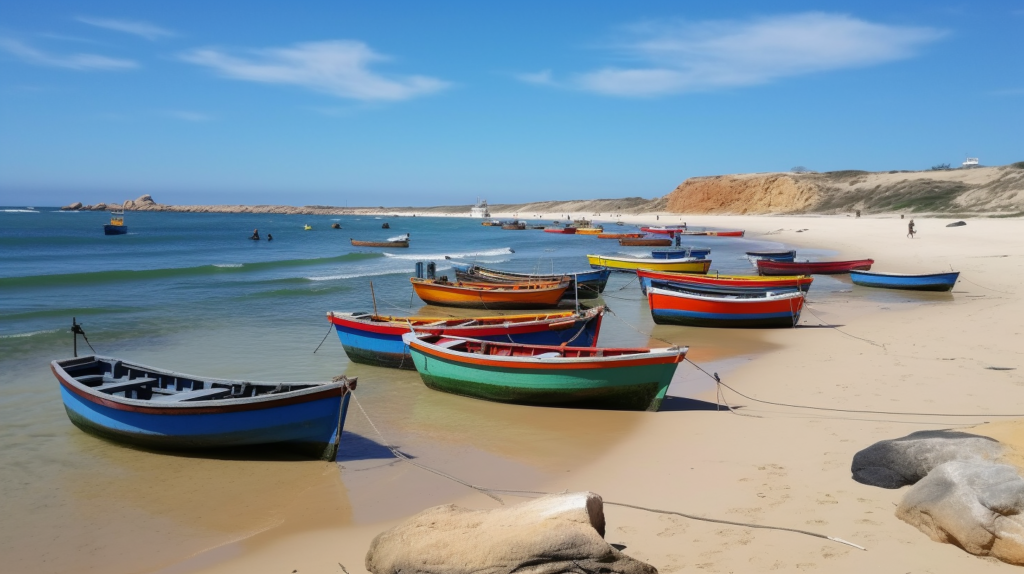
The Alentejo region in Portugal is known for its rich cultural heritage, stunning natural landscapes, and delicious cuisine. From traditional dishes to historical sites and beautiful beaches, Alentejo offers a unique experience for travelers.
The Alentejo region in southern Portugal is known primarily for its vast agricultural landscape and rich cultural heritage. Food and wine are highly influential to the local economy and way of life. Alentejo is one of Portugal’s largest and most productive breadbaskets, especially renowned for cork, olive oil, tomatoes and wine varieties like Herdade da Cartuxa and Borba. The region’s countryside dotted with medieval villages is scenic yet Sparsely populated.
Historic cities like Évora contain impressive monuments dating to Roman times as well as distinctive Alentejo architecture. Local cuisine also heavily features game meats along with seasonal vegetables and cheeses. Alentejo’s unique folk traditions persist through dance performances, pottery crafts and singing called cante alentejano. Overall, the region promotes a slower pace centered around nature, farming traditions and historical small towns.
Key Takeaways
- Alentejo is renowned for its traditional dishes that showcase the region’s culinary heritage.
- The use of local ingredients, such as olive oil and herbs, is a key element in Alentejo’s cuisine.
- Alentejo is famous for its wine culture, with vineyards producing high-quality wines.
- The region boasts a wealth of historical heritage, including impressive castles and well-preserved Roman ruins.
- Alentejo’s natural beauty can be seen in its vast cork oak forests, golden plains, and picturesque coastline with beautiful beaches.
Cuisine in Alentejo
Traditional Dishes
The Alentejo region is a treasure trove of culinary delights. Migas and açorda are staples, embodying the soul of local cuisine. These bread-based dishes are often paired with succulent pork or fresh seafood, creating a harmony of flavors.
- Migas – Bread crumbs with seasonings, often served with pork.
- Açorda – A bread and garlic soup, sometimes enriched with fish or shellfish.
- Pork Loin – Marinated in regional spices, then grilled to perfection.
- Lamb Stew – Slow-cooked with local herbs, a comfort food favorite.

The simplicity of Alentejo’s dishes belies their deep, rich flavors. Each bite tells a story of tradition and the land.
Wine is a frequent companion at the Alentejo table, enhancing the dining experience. The region’s hearty cuisine is best enjoyed with a glass of local red or white, each sip echoing the earthy tones of the dishes.
Local Ingredients
The Alentejo is a treasure trove of authentic flavors. Black pork, free-range and acorn-fed, is a regional staple, renowned for its rich taste. Olive oil here is liquid gold, with a distinct, fruity profile that elevates every dish.
- Black pork
- Olive oil
- Bread
- Cheese
- Herbs
These ingredients form the backbone of Alentejo’s culinary identity. The bread, often baked in wood-fired ovens, is crusty outside and soft inside. Cheese, from sheep or goat milk, ranges from creamy to piquant. Aromatic herbs like coriander and mint add layers of flavor.
The Alentejo’s pantry is a reflection of its landscape: simple, robust, and deeply satisfying.

Wine Culture
Alentejo’s wine culture is as rich as its soil. Vineyards stretch across the horizon, a testament to the region’s dedication to viticulture. The talha wine-making tradition, a method dating back to Roman times, is still celebrated here. It involves fermenting wine in large clay pots, offering a unique taste experience.
- Indigenous grape varieties thrive in Alentejo, each contributing to the region’s diverse wine portfolio.
- Field blends, where multiple grape varieties are grown and harvested together, add complexity to Alentejo wines.
- Innovation in winemaking techniques ensures that tradition meets modernity, resulting in wines that are both authentic and contemporary.
Alentejo is a wine lover’s paradise, where ancient practices and new innovations blend seamlessly to create exceptional wines.
Whether you’re a connoisseur or a casual enthusiast, the wines of Alentejo promise an enchanting journey through flavor and history.
Historical Heritage
Castles and Fortresses
The Alentejo region is a treasure trove of historical fortifications. Majestic castles stand as sentinels over the rolling hills, each telling a story of a bygone era. Among them, Monsaraz Castle offers breathtaking views, while the imposing walls of Castelo de Palmela whisper tales of ancient battles.
- Monsaraz Castle and Walls
- Castelo de Palmela
- Castelo da Rainha Santa
These fortresses are not just relics; they are vibrant parts of the community, hosting events and festivals throughout the year. Budget-friendly and rich in history, they are a must-visit for any traveler.
The Alentejo’s castles are more than monuments. They are chapters in the region’s living history book.

Roman Ruins
The Alentejo is a treasure trove of ancient history, with Roman ruins scattered across the landscape. One of the most remarkable sites is the Roman City of Ammaia near Marvão. This site, though often overlooked, offers a unique glimpse into the past.
- Roman City of Ammaia
- Villa of São Cucufate
- Roman Temple of Évora
Each location tells a story of a civilization that once thrived here. The ruins are not just stones; they are the echoes of ancient lives and a testament to the region’s historical significance.
The Alentejo’s Roman ruins are more than mere attractions; they are portals to a bygone era, inviting visitors to step back in time and experience the grandeur of the Roman Empire in Portugal.
Historic Towns
The Alentejo region is a tapestry of time-worn towns, each telling a story of a bygone era. Step into the past as you wander through the narrow streets of Évora, a UNESCO World Heritage site brimming with history. Not far behind in charm are towns like Monsaraz and Vila Viçosa, where time seems to stand still.
- Évora: A historical gem with Roman roots.
- Monsaraz: Perched high, offering panoramic views.
- Vila Viçosa: Known for its marble and royal tales.
The Alentejo’s towns are not just relics; they are living museums, inviting exploration and discovery.
Among these, Vila Nova de Milfontes shines with a unique allure, often overshadowed by the more famous Comporta or Melides. Yet, it remains one of the 15 prettiest towns in Portugal, a testament to the region’s understated beauty.
Natural Beauty
Cork Oak Forests
The Alentejo’s montados are a testament to nature’s splendor and human sustainability. Stroll through the whispering cork oak forests and you’ll feel a deep connection to Portugal’s natural heritage. These trees are not just a backdrop for serene walks; they’re the lifeblood of the local economy.
- Cork harvesting supports local communities.
- The ecosystem is a haven for biodiversity.
- Cork products are a symbol of sustainable living.
The cork oak landscapes of Alentejo are as much a cultural icon as they are an ecological treasure. They embody a tradition that marries nature with livelihood.
Trekking tours in Alentejo offer a rare journey through the region’s magnificent cork oak forests, known as “montados.” These ancient forests have stood for centuries, marking the passage of time with each layer of bark.
Golden Plains
The Alentejo region’s golden plains are a sight to behold. Miles of undulating fields shimmer under the Portuguese sun, painting a picture of tranquility and timelessness. These vast expanses are not just beautiful; they’re also productive, contributing significantly to Portugal’s agriculture.
- Wheat and barley sway in the breeze.
- Olive groves dot the landscape.
- Sunflowers turn their faces to the sun.
The golden plains of Alentejo are the canvas of the region, where nature’s colors blend into a masterpiece of simplicity and beauty.
The serenity of the plains invites visitors to slow down and appreciate the ‘considered way of life‘ that defines Alentejo. It’s a place where tradition and nature coalesce, offering a unique experience for those who wander through its poetic landscapes.
Coastline and Beaches
The Alentejo’s coastline is a breathtaking tapestry of unspoiled beauty. Golden sands stretch far beyond the eye can see, meeting the crystal-clear waters of the Atlantic. This region is a haven for surfers, nature lovers, and those seeking tranquility away from crowded tourist spots.
Beaches like Comporta and Zambujeira do Mar are jewels of the coast, offering a blend of natural charm and local culture. Here, the rhythm of the waves dictates the pace of life.
- Praia de Melides: Serene and family-friendly
- Porto Covo: Rugged cliffs and picturesque coves
- Vila Nova de Milfontes: Vibrant summer destination
The Alentejo coast is not just a place to relax and soak up the sun. It’s a region rich with maritime history, where each cove and cliff tells a story of seafarers and fishermen.
Whether you’re exploring the coastal trails or indulging in the fresh seafood, the Alentejo coastline is an unforgettable part of Portugal’s natural heritage.
Conclusion
In conclusion, the Alentejo region is known for its rich cultural heritage, stunning landscapes, delicious cuisine, and warm hospitality. Whether you are a history buff, a food enthusiast, or a nature lover, Alentejo has something to offer for everyone. From the charming villages to the vineyards and olive groves, this region is a hidden gem waiting to be explored. Plan your next trip to Alentejo and immerse yourself in the beauty and authenticity of this captivating destination.
Frequently Asked Questions
What are some traditional dishes in the Alentejo region?
Some traditional dishes in the Alentejo region include Açorda, Migas, and Carne de Porco à Alentejana.
What local ingredients are commonly used in Alentejo cuisine?
Common local ingredients used in Alentejo cuisine are olive oil, bread, pork, and herbs like coriander and oregano.
How is the wine culture in the Alentejo region?
The Alentejo region is known for its rich wine culture, producing high-quality wines such as Vinho Verde and Alentejo reds.
What are some notable castles and fortresses in Alentejo?
Some notable castles and fortresses in the Alentejo region are Castelo de Monsaraz and Castelo de Estremoz.
Are there any significant Roman ruins in Alentejo?
Yes, Alentejo is home to impressive Roman ruins like the Temple of Diana in Évora.
What are the main natural attractions in the Alentejo region?
The main natural attractions in Alentejo include the vast Cork Oak Forests, the Golden Plains, and the beautiful coastline with sandy beaches.

